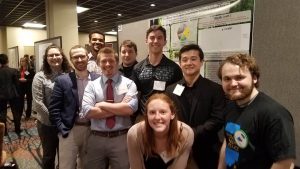Dead spiders in tubes with microscopes zeroing in on every part of their body might seem like a scene out of an upcoming horror film, but it is also some of the work that University of Indianapolis Assistant Professor of Biology Marc Milne completes in spider taxonomy. Taxonomy is a branch of science concerned with the classification of animals and insects. Milne’s work in the field of spider taxonomy has been featured on Fox News, The Indianapolis Star and ABC News.

Milne said that he routinely asks students that excel academically and have interest in spider research to join him on portions of his research. Milne said he wants to present research opportunities to both underclassmen and upperclassmen. Sophomore biology and chemistry double major Caylie Wimmersberger said that she started helping Milne on research as a freshman.
“Freshman year, first semester I had a beginner biology class with him [Milne]. The topic [about my] minor in art came up,” Wimmersberger said. “He just had a student recently graduate that was illustrating some of his spiders that he was identifying. I am now working with him to illustrate some of those spiders that he’s discovering and adding to a database.”
Wimmersberger is not the only student that Milne researches with. Milne said that this past summer, he invited students to survey and collect specimens. According to Milne, said that giving students these opportunities give them an edge when going to the next step of their education: whether it’s graduate school or a career.
“I have a lot of projects that are not directly related to capstone projects. I ask all my students if they’d like to join my projects, a lot of them volunteer. They get a lot of experience, free food and cool swag,” Milne said. “I ask students to do things such as go to a BioBlitz. It’s one or two days where taxonomists of different groups converge on a location and try to find and identify as many specimens they can.”
Milne’s leadership style and the opportunities have helped Wimmersberger ger ahead of her studies, she said. Because of her work with Milne, she has developed a portfolio that will pour into some of her other classes and work along with preparing her for a career in the future.
“Being a part of his [Milne’s] research team has been really eye opening and helpful especially because this is going to be my honor’s project.” Wimmersberger said. “It’s amazing because I will already be able to start my honor’s project as a first semester sophomore and getting that out of the way.”
Milne also discovered a new rare species of spider in an Indiana cave in 2018. The species, Islandiana lewisi, is one of the primary reasons for Milne’s media coverage. However, according to Milne, his research comes rather quiet when talking to peers and colleagues at UIndy, and he’s okay with it.
“People have their own research. A lot of them are distinguished in their own ways. I don’t think I am anymore distinguished than anyone,” Milne said. “Many professors do not do any research at all and they only focus on teaching. They don’t have any research. However, there are many other faculty members that do research.”
Milne’s research started out during his senior year of his undergraduate career, which he carried into his studies in graduate school. However, when he first began college, he was studying a carnivorous plant and spiders made an entrance into his studies.
“I noticed spiders when examining pitcher plants,” Milne said. “Spiders would build webs over the entrance to the cup. They would collect the insects instead of the plant. When I applied to graduate school I just wrote that down.”
Even though his research and work is primarily focused on spiders, Milne said that the work he is doing will likely help different areas such as ornithology and environmental science.
All parts of an ecosystem coexist. One example has been given a lot of wind in recent years.
“Spiders, often times, are organisms that are indicators on how healthy an ecosystem such as pollinators. It’s very hard to capture how many pollinators, such as bees, are in a habitat because they move so much and [have] hives in other places,” Milne said. “Spiders usually stay in one place. Spiders are very sensitive to insect density. If there are a lot of insects and pollinators, they’re going to be a lot of spiders.”







